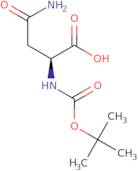Boc-L-Asn-OH
CAS: 7536-55-2
Ref. 3D-FB37759
| 1kg | Ausgelaufen | ||
| 50g | Ausgelaufen | ||
| 100g | Ausgelaufen | ||
| 250g | Ausgelaufen | ||
| 500g | Ausgelaufen |
Produktinformation
- (2S)-2-((tert-Butoxycarbonyl)amino)-3-carbamoylpropanoic acid
- (2S)-2-[[(tert-Butoxy)carbonyl]amino]-3-carbamoylpropanoic acid
- (2S)-4-Amino-2-[(2-methylpropan-2-yl)oxycarbonylamino]-4-oxobutanoic acid
- (2S)-4-amino-2-[(tert-butoxycarbonyl)amino]-4-oxobutanoate
- (S)-2-tert-Butoxycarbonylamino-succinamic acid
- (S)-4-Amino-2-[(tert-butoxycarbonyl)amino]-4-oxobutanoic acid
- <span class="text-smallcaps">L</span>-Asparagine, N<sup>2</sup>-[(1,1-dimethylethoxy)carbonyl]-
- Asparagine, N<sup>2</sup>-carboxy-, N<sup>2</sup>-tert-butyl ester, <span class="text-smallcaps">L</span>-
- BOC-<span class="text-smallcaps">L</span>-asparagine
- BOC-Asparagine
- Mehr Synonyme anzeigen
- Boc-<span class="text-smallcaps">L</span>-Asn-OH
- Boc-Asn-OH
- Boc-L-asparagine
- N-(tert-Butoxycarbonyl)-<span class="text-smallcaps">L</span>-asparagine
- N-Boc-<span class="text-smallcaps">L</span>-asparagine
- N<sup>2</sup>-[(1,1-Dimethylethoxy)carbonyl]-<span class="text-smallcaps">L</span>-asparagine
- N<sup>2</sup>-tert-Butoxycarbonyl-<span class="text-smallcaps">L</span>-asparagine
- N<sup>α</sup>-(tert-Butoxycarbonyl)asparagine
- N<sup>α</sup>-tert-Butoxycarbonyl-<span class="text-smallcaps">L</span>-asparagine
- NSC 154980
- N~2~-(tert-butoxycarbonyl)-D-asparagine
- N~2~-(tert-butoxycarbonyl)-L-asparagine
- Piperidine-1,3-dicarboxylic acid 1-tert-butyl ester
- tert-Butoxycarbonyl-<span class="text-smallcaps">L</span>-asparagine
- tert-Butyloxycarbonyl-<span class="text-smallcaps">L</span>-asparagine
Boc-L-Asn-OH is a cyclic peptide that belongs to the group of glycopeptides. It consists of a hydrogen bond between the nitrogen atom in the amide group and the oxygen atom in the hydroxyl group. Boc-L-Asn-OH has been shown to be an inhibitor of growth factor activity and may have some antiviral activity against herpes simplex virus. Boc-L-Asn-OH is soluble in organic solvents such as chloroform and ethanol, but insoluble in water. This compound also has a carboxy terminal that can be modified with various substituents, which can affect its properties.





